Smart Textiles Design Lab Blog at The Swedish School of Textiles
Sensor Gloves

This project is an attempt to have e-textile sensor gloves produced in one piece on a conventional industrial knitting machine with most of the necessary sensor yarn and connections integrated into the knitting pattern.
Textile sensors can be conveniently use to track body movement, but the interpretation of the sensor data is not trivial. There is thus a strong benefit in combining textile sensors and artificial intelligence to compensate for the electronic peculiarities of the textile sensors such as high noise levels and wear-out.
What made working on the glove pattern interesting was the integration of the textile electronic into a specific object and application context, and to learn about the opportunities and problems that accompany this process. While there are several sensor gloves that could be used for the same purpose, and many handmade e-textile gloves, there are only few attempts to develop towards an industrially knit glove and to support the sensor precision with a high amount of expertise from artificial intelligence.
Stretch and pressure are very common sensors to be used in textiles – mostly because these kind of material deformations routinely happen with textile materials and therefore conveniently complement the sensing capabilities of hard shell wearable devices. Pressure and pulling sensors also provide useful information about the wearer, for example to track movements of the torso and limbs.
For a smart glove, it makes sense to integrate stretch sensors into the back of the fingers to track their movements. I used two different materials that can act as stretch sensors: Piezo-resistive and piezo-electric yarn.
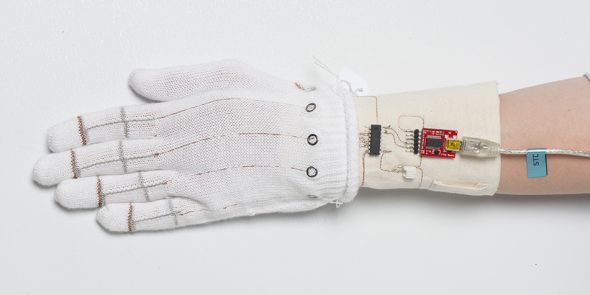
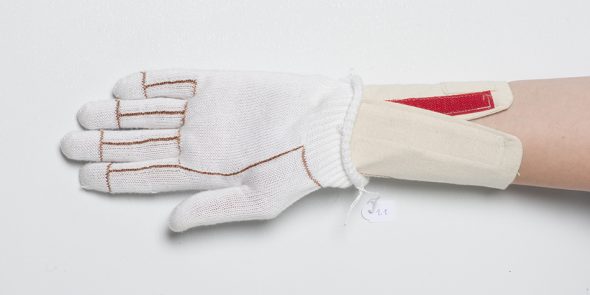
Piezo-resistivity denotes an electro-mechanical behaviour where a material changes its resistive properties under pressure or tug. This property is common with conductive multifilament yarns, however some materials have a much more distinct piezo-resistive response and that can be very efficiently applied as sensor yarns. In the yarns that I used are a blend of standard polyester fibres and short stainless steel fibres. Under pressure, the short fibres make a much better electrical contact than in a relaxed state, which can be measured with a micro controller. The interpretation of the sensor data is also very straightforward, because the amount of mechanical force corresponds to the change in resistivity.
Piezo-electric materials also react to pressure and tug, however not with a change in resistivity, but a change in electrical potential or voltage. The deformation thus changes the potential between two poles in the material and thus produces a small voltage. The change in voltage produced by the piezoelectric fibre is very small and thus needs to be amplified to be measurable with the kind of microcontrollers that I used. In turn, the piezoelectric signal is much more precise than the piezo-resistive signal.
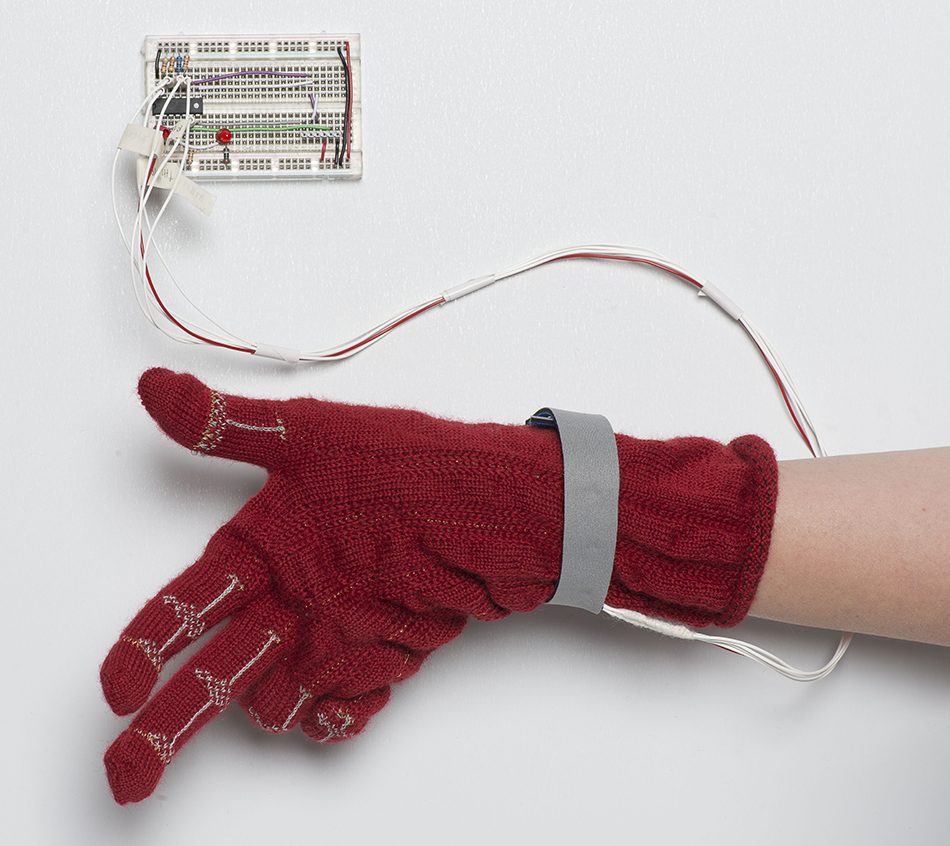
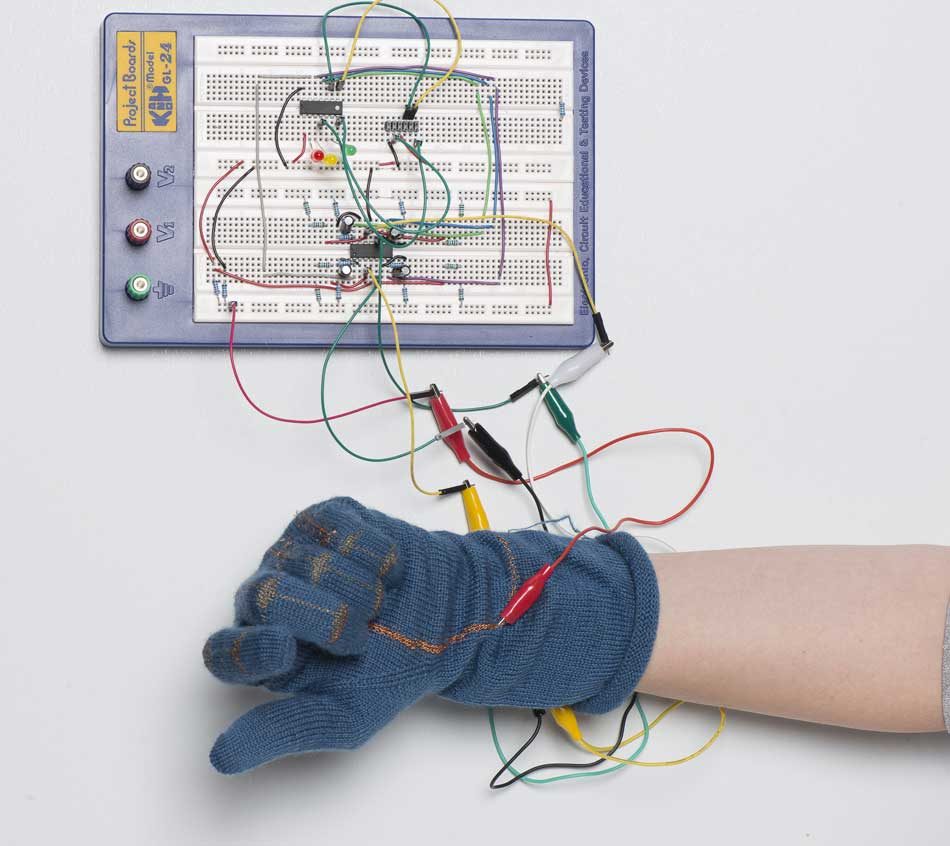
The development of both glove patterns went through several iterations. The main challenge was to find ways to reconcile the requirements for a data glove in terms of sensor placement and connection with the capabilities of the knitting machine. The data glove should preferably provide separated sensors with a reliable response on each finger. This required that the sensors could be as long as possible and that the glove provided a good fit for the wearer without wearing out the sensors. The sensors should be connected to the microcontroller through knitted connections that should not affect the sensor signal when the glove was worn and moved.
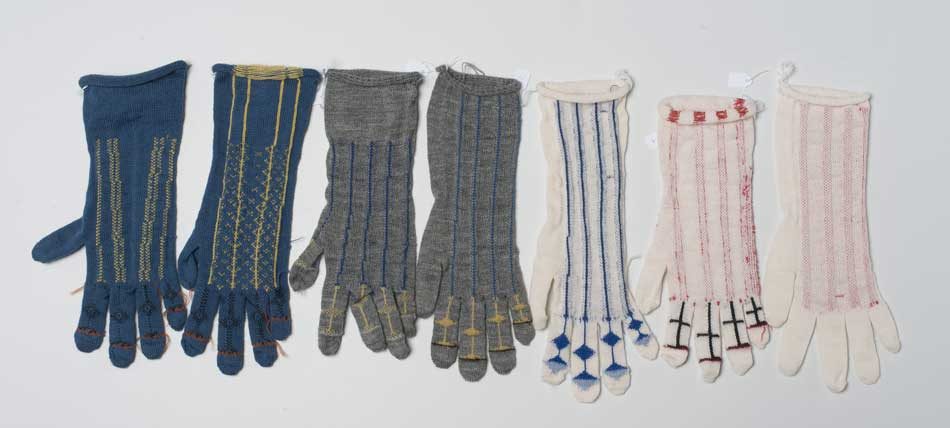
I produced a version of the glove with sensors on four fingers with both sensor yarns, and another version that included the thumb only for the piezo-resistive yarn. All finger sensors on the glove reacted and produced a reasonable range when the fingers were bent. At the same time, it was not obvious from the values alone to determine which fingers were actually bent at the same time: Only if a finger was bent with both finger joints did the sensor produce a maximum output. For real-life gestures and movements, this is hardly the case. Only if the wearer opens the hand entirely or forms a fist do the sensors reach their minimum and maximum values. However the values were more ambiguous for all other hand gestures.
For Gauss Lee (my fellow researcher at Skövde university and a computer scientist) to use the sensor data, he needed a suitable artificial intelligence algorithm to make sense of the glove data. This algorithm needs to be trained, i.e. fed with a set of existing values that represent certain gestures. Gauss thus captured a set of several hundred values for these gestures. This should also ensure that the algorithm would recognize the gestures correctly in spite of the large fluctuations that occurred on the sensor readings. Gauss set up a simple software in which the NAO robot tells the glove wearer to display a certain number between zero and five, and checks if he or she displays the number correctly, which was demonstrated to the steering committee from VGR.
This project was part of the research activity „Design, Textiles and Sustainable Development“ of the universities of Borås and Skövde, funded by Västragötalandsregionen.
Katharina Bredies, postdoctoral researcher
